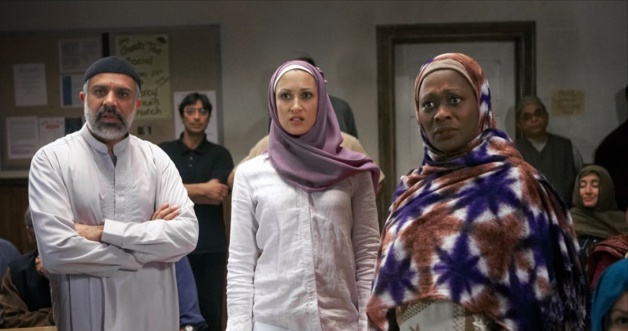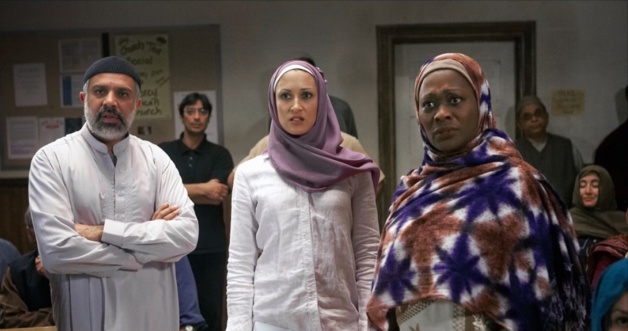
Without any doubts, Little Mosque on the Prairie is more than a simple TV show. Zarqua Nawaz, of Pakistani origin, born in Liverpool and raised in Toronto is the one who took the initiative to make this TV show, which became a real international cultural phenomenon. The sitcom, which was broadcasted between 2007 and 2012 on the Canadian channel CBC, has indeed more the form of a good booster injection. It is not a coincidence if there is a reference about the TV show “Little House on the Prairie”, which recounts the story of an American pioneer family moving in the Minnesota during the XIX century. Filmed in Toronto, Little Mosque on the Prairie focus on the everyday life of a Muslim community of a small fictitious town in a quiet Canadian region of Ontario called Mercy. The TV show plays with the cliché associated with Islam and the Muslim community in this traditionally Christian urban area, where the slightest move makes the biggest noise.
Irony and self-deprecation: the end of the cliché
The plot begins with the arrival of a new imam called Amaar Rashid, a lawyer of formation who has come straight from Toronto to the new mosque in Mercy. His liberal and progressive tendencies look to temper the conservative impetus of some members of the community, such as Babber Siddiqui. In one of the most comical episodes, the latter want to build a wall between women and men within the prayer room, in order to prevent any “unfocus” caused by the womankind. This initiative provokes conflicts amongst Mercy’s Muslims, and even spreads outside the wall of the mosque when the inhabitants of the town start to demonstrate for the rights of women. Zarqa Nawak doesn't hesitate to play with stereotypes usually linked to Islam in western society: those of a conservative and traditional aversion to any sort of modernism.
The director doesn't hesitate with this TV show to deliberately overstate the point of those stereotypes in order to make us realize how much some prejudice beliefs about Islam can be wrong and come from an ignorance of the religion and its traditions. All of that with a lot of humor. We can't help but laugh when an inhabitant of Mercy enters the little church which has been bought and transformed into a mosque and then runs for his life after seeing the morning prayers!
Little Mosque on the Prairie gives us an overview of a relaxed and modern Islam thanks to diversified and extravagant characters and that for the well-being of our moral.
Thinking about the ethnocentrism of Islam in the media
In a post 9/11 context, the TV show particularly questions the role of the media in the construction of the Muslim identity and of the image of the Muslims in North America and the West as a whole. When the new Imam Amaar got arrested by the security service on “suspicion of terrorist acts” the police questioning before he boards a plane at the airport is one of the most folkloric scenes of the series. He accentuates the paranoia caused by the World Trade Center attacks, the suspicion of the Muslim “terrorist to become” is present everywhere. Zarqa Nawaz cleans up with a lot of humor and irony the image of Islam and its believers, who are always in the spotlights of the critic, of pseudo-analysis and of hidden extremists’ suspicions. She succeeds with vigor in wiping away the constant association of Islam with the turbulent news of the Middle East, from the beginning of the war in Iraq to the explosion of the radical uses of the religion. In Little Mosque on the Prairie it is more about Islam as a religion and as a community, which advocates peace, tolerance and modernity.
Moreover the TV show tries to show a reality which has been present for years, especially in Canada: the integration of immigrants and of the Muslim people in the society. Most of the characters belong to different socio-cultural environments and are often educated: we can find a student, an employee of the Canadian government, a lawyer, a college teacher or a CIO. But, more specifically, Zarqa Nawak wants to get away from the chronic Orientalism, which put a wall between “them” in the East and “us” in the West. The tales of the Arabian nights and the exoticism of Persian princes riding their thoroughbred are over because of the destructions of the construction of a cultural identity and the idea of “The Eastern”: thanks to Little Mosque on the Prairie we take a global view of our preconceived ideas and we are closer to what the Islam symbolizes.
A politicized TV show, which made some noise
Furthermore, the sitcom did not go unnoticed. Among the telegrams of the American diplomacy revealed by WikiLeaks in 2010 we could find some correspondences between Washington and the Canadian government in Ottawa. The American diplomats in question mentioned that Little Mosque on the Prairie was a carrier of negatives stereotype about the Americans and made a very pejorative comparison between Canada and the United States about the “American Dream”.
On a wider scale, Little Mosque on the Prairie was benefited by huge media exposure. At its launch in 2007, the first episode was watched by more than two millions of Canadians! Since then, it was broadcasted in more than 80 different countries, such as Europe on Canal+ (2007), Swiss on TSRI (2010) or Belgium on La Deux (2013). Even if the project was relatively delicate, especially after the scandal of the Danish caricatures about the Mahomet Prophet in 2005, the TV show became a real cultural phenomenon, reviving the debates about the image of Islam in western countries and about the stereotypes associated with the popular culture. The TV show made us understand that Muslims are not just Muslims: they are citizens, teachers, students, parents, political activists… Little Mosque on the Prairie is one of the first TV shows which talks about Islam’s image in the media and tries to rebuild it. And it feels good.
In general, the sitcom was a great success, especially in North America, the Middle East and in Asia with their big Muslim communities. Muslim people can laugh and can make laugh. However, the phenomenon Little Mosque on the Prairie doesn’t seem to have the same success in Europe. In this academic article “Toward Media Reconstruction of the Muslim Imaginary in Canada”, the researcher quotes the interpretation of Zarqa Nawaz “I think the reason it wasn't made in Europe was because the Muslim experience in Europe has been very different than the Muslim experience in North America. For the most part, the Muslim community has been for more assimilated and has integrated more successfully in North America”. It seems that the Old Continent has still big progress to make.




























